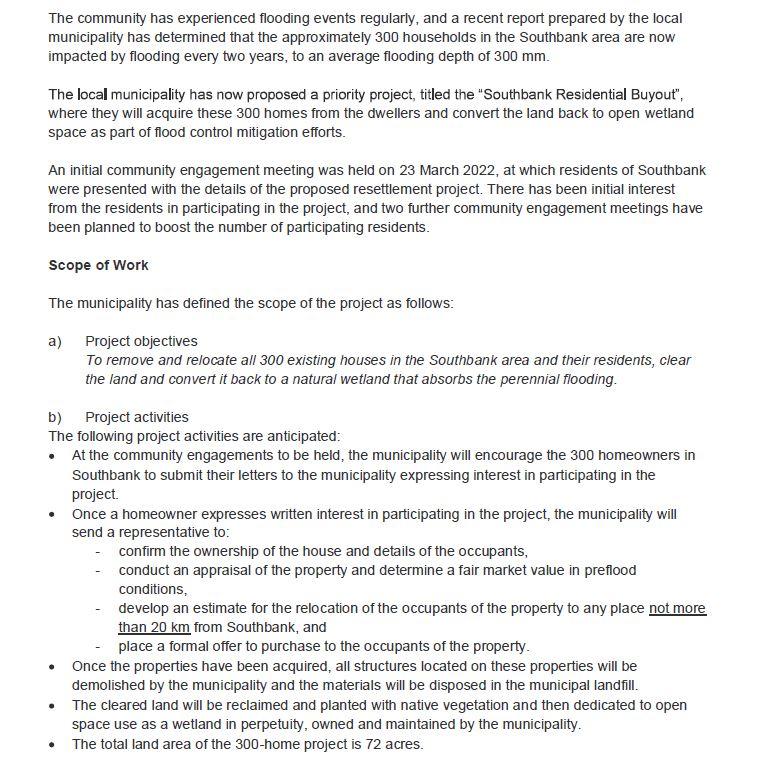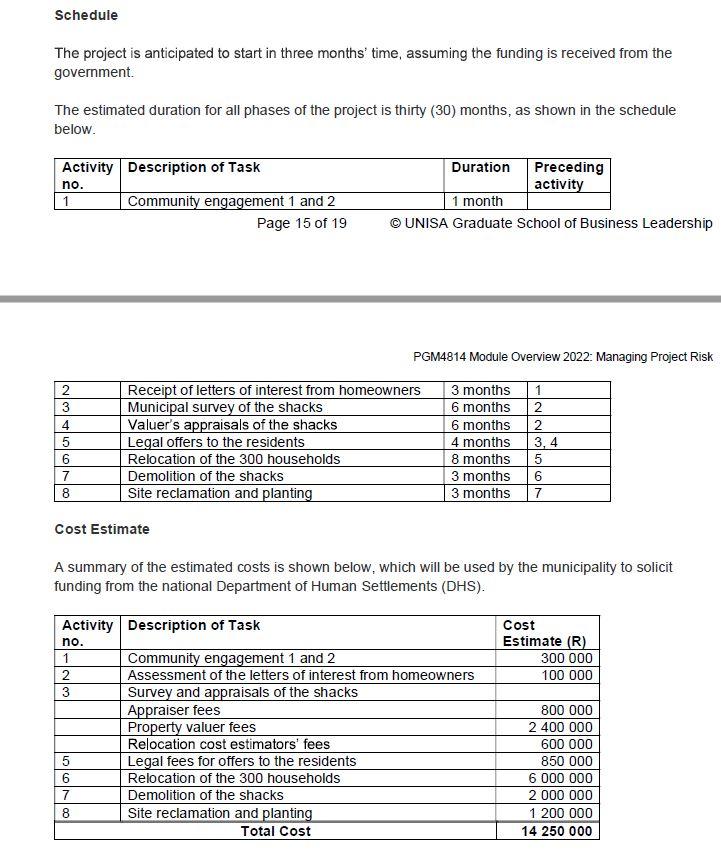Question
TASK: The municipality has approached the DHS to fund the entire costs of the project above. The DHS has, in turn, appointed you to carry



TASK: The municipality has approached the DHS to fund the entire costs of the project above. The DHS has, in turn, appointed you to carry out a risk assessment of the project so that they can determine the probable chances of success of the project and the key issue that might cause project failure and whether they should fund the project.
c) In your view, identify the main risks that may negatively impact the project meeting its objectives. The DHS would ideally like to identify and focus on only the top ten risks.
d) Using a risk assessment matrix, analyse the identified risks.
e) Develop a risk response matrix to outline each of the risks that should be dealt with, who should deal with the risks and the risk triggers.
f) Recommend to the DHS whether it is worth funding the project from a risk management perspective and considering the risks only..
Background The Southbank neighbourhood is a low-lying residential area outside Cape Town that attracts migrants from the city and further afield. People settled in Southbank - an entirely informal settlement - in the early 1970 s. Most of the residents in the flats live in informal housing, characterised by cramped conditions and a lack of infrastructure such as sanitation and stormwater drainage. Most dwellers either buy a shack on the informal housing market or claim an open piece of land and build makeshift shacks with inferior materials, usually corrugated iron sheets. Most informal houses have no running water or electricity and have a pit latrine toilet for sanitation. Ownership of the land in the area is unclear, as although the land is owned by the municipality and the residents have no formal rights to land. They are protected by legislation that restricts their removal, and they do have informal rights to the land. The land is generally very flat and sandy, and it is a natural wetland with a high water table that is susceptible to flooding. During the dry summer months, the settlement is fine, but during winter, it frequently rains in this area, resulting in floods that stagnate for days and bring debris and household waste into the streets, homes and businesses. The high number of immigrants into the area and the surrounding formal housing developments also contribute to increased flooding, as more areas are paved over and natural wetlands are diminished. The community has experienced flooding events regularly, and a recent report prepared by the local municipality has determined that the approximately 300 households in the Southbank area are now impacted by flooding every two years, to an average flooding depth of 300mm. The local municipality has now proposed a priority project, titled the "Southbank Residential Buyout", where they will acquire these 300 homes from the dwellers and convert the land back to open wetland space as part of flood control mitigation efforts. An initial community engagement meeting was held on 23 March 2022, at which residents of Southbank were presented with the details of the proposed resettlement project. There has been initial interest from the residents in participating in the project, and two further community engagement meetings have been planned to boost the number of participating residents. Scope of Work The municipality has defined the scope of the project as follows: a) Project objectives To remove and relocate all 300 existing houses in the Southbank area and their residents, clear the land and convert it back to a natural wetland that absorbs the perennial flooding. b) Project activities The following project activities are anticipated: - At the community engagements to be held, the municipality will encourage the 300 homeowners in Southbank to submit their letters to the municipality expressing interest in participating in the project. - Once a homeowner expresses written interest in participating in the project, the municipality will send a representative to: - confirm the ownership of the house and details of the occupants, - conduct an appraisal of the property and determine a fair market value in preflood conditions, - develop an estimate for the relocation of the occupants of the property to any place not more than 20km from Southbank, and - place a formal offer to purchase to the occupants of the property. - Once the properties have been acquired, all structures located on these properties will be demolished by the municipality and the materials will be disposed in the municipal landfill. - The cleared land will be reclaimed and planted with native vegetation and then dedicated to open space use as a wetland in perpetuity, owned and maintained by the municipality. - The total land area of the 300 -home project is 72 acres. Schedule The project is anticipated to start in three months' time, assuming the funding is received from the government. The estimated duration for all phases of the project is thirty (30) months, as shown in the schedule below. Page 15 of 19 (c) UNISA Graduate School of Business Leadership PGM4814 Module Overview 2022: Managing Project Risk Cost Estimate A summary of the estimated costs is shown below, which will be used by the municipality to solicit funding from the national Department of Human Settlements (DHS)Step by Step Solution
There are 3 Steps involved in it
Step: 1

Get Instant Access to Expert-Tailored Solutions
See step-by-step solutions with expert insights and AI powered tools for academic success
Step: 2

Step: 3

Ace Your Homework with AI
Get the answers you need in no time with our AI-driven, step-by-step assistance
Get Started


